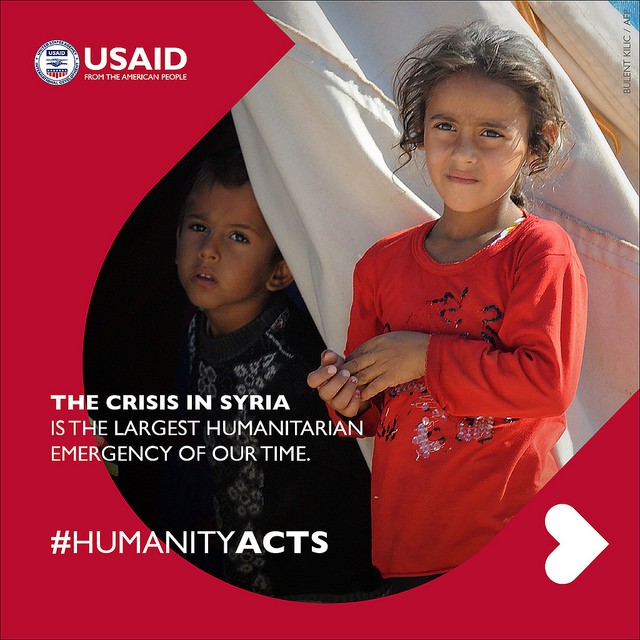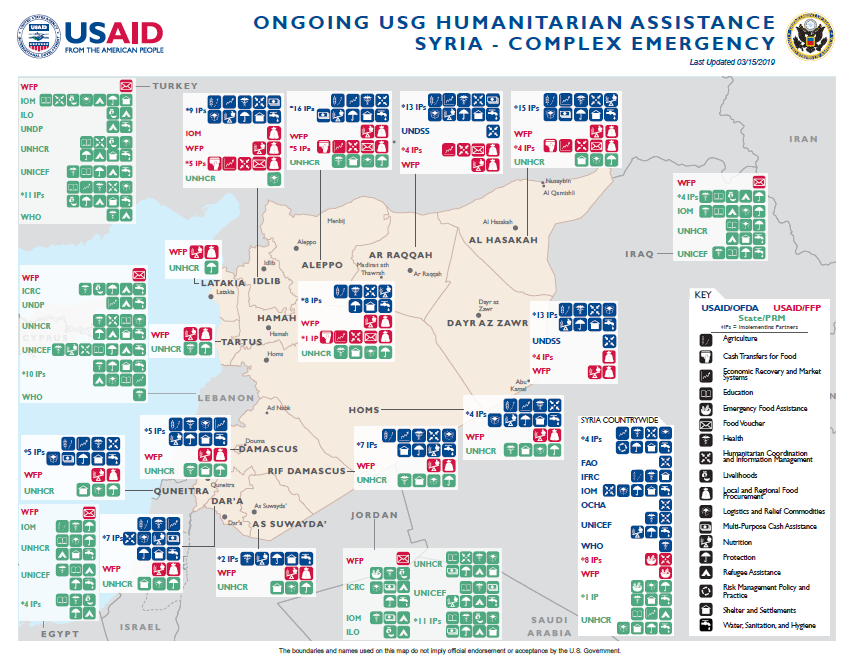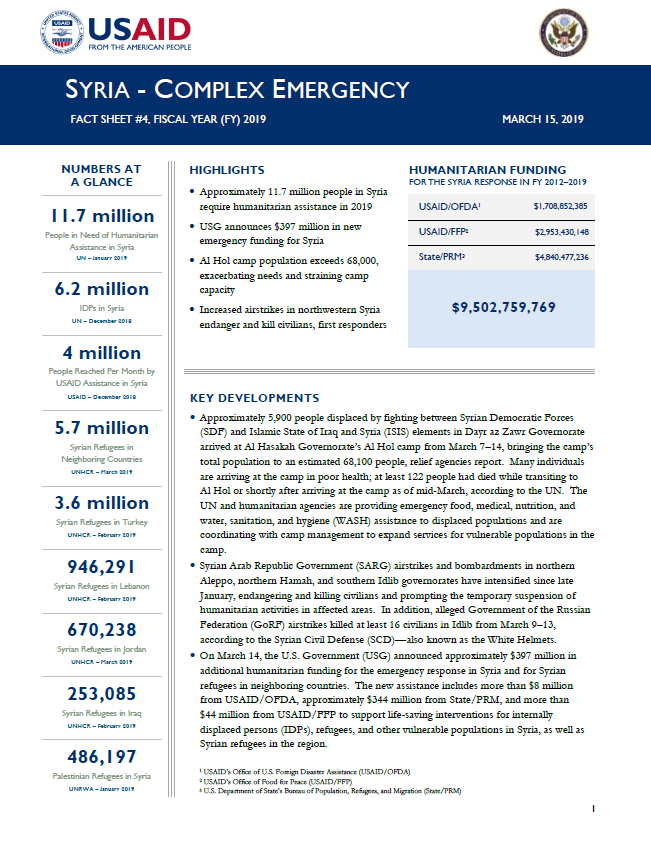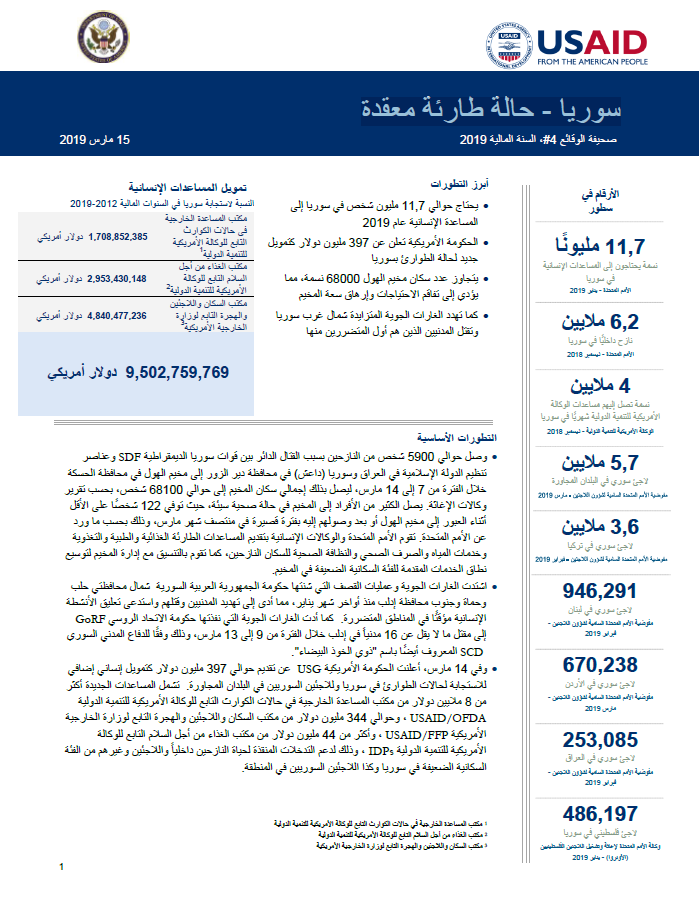- What We Do
- Agriculture and Food Security
- Democracy, Human Rights and Governance
- Economic Growth and Trade
- Education
- Environment and Global Climate Change
- Gender Equality and Women's Empowerment
- Global Health
- Humanitarian Assistance
- Transformation at USAID
- Water and Sanitation
- Working in Crises and Conflict
- U.S. Global Development Lab
Speeches Shim
March 15, 2019
Highlights
Approximately 11.7 million people in Syria require humanitarian assistance in 2019
USG announces $397 million in new emergency funding for Syria
Al Hol camp population exceeds 68,000, exacerbating needs and straining camp capacity
Increased airstrikes in northwestern Syria endanger and kill civilians, first responders
Key Developments
Approximately 5,900 people displaced by fighting between Syrian Democratic Forces (SDF) and Islamic State of Iraq and Syria (ISIS) elements in Dayr az Zawr Governorate arrived at Al Hasakah Governorate’s Al Hol camp from March 7–14, bringing the camp’s total population to an estimated 68,100 people, relief agencies report. Many individuals are arriving at the camp in poor health; at least 122 people had died while transiting to Al Hol or shortly after arriving at the camp as of mid-March, according to the UN. The UN and humanitarian agencies are providing emergency food, medical, nutrition, and water, sanitation, and hygiene (WASH) assistance to displaced populations and are coordinating with camp management to expand services for vulnerable populations in the camp.
Syrian Arab Republic Government (SARG) airstrikes and bombardments in northern Aleppo, northern Hamah, and southern Idlib governorates have intensified since late January, endangering and killing civilians and prompting the temporary suspension of humanitarian activities in affected areas. In addition, alleged Government of the Russian Federation (GoRF) airstrikes killed at least 16 civilians in Idlib from March 9–13, according to the Syrian Civil Defense (SCD)—also known as the White Helmets.
On March 14, the U.S. Government (USG) announced approximately $397 million in additional humanitarian funding for the emergency response in Syria and for Syrian refugees in neighboring countries. The new assistance includes more than $8 million from USAID/OFDA, approximately $344 million from State/PRM, and more than $44 million from USAID/FFP to support life-saving interventions for internally displaced persons (IDPs), refugees, and other vulnerable populations in Syria, as well as Syrian refugees in the region.
Syria Complex Emergency - Map #4 FY19 ![]() (pdf - 458k)
(pdf - 458k)
Numbers At A Glance
11.7 million
6.2 million
4 million
5.7 million
3.6 million
946,291
670,238
253,085
486,197
Humanitarian Funding
To Syria Humanitarian Response
FY 2012 - FY 2018
| USAID/OFDA | $1,708,852,385 |
| USAID/FFP | $2,953,430,148 |
| State/PRM | $4,840,477,236 |
| TOTAL | $9,502,759,769 |
Syria Complex Emergency - Fact Sheet #4 FY19 ![]() (pdf - 399k)
(pdf - 399k)
4 سوريا حالة طارئة معقدة - صحيفة الوقائع ![]() (pdf - 605k)
(pdf - 605k)
CURRENT EVENTS
Approximately 11.7 million Syrians—or nearly 59 percent of the country’s estimated population of 20 million—will require humanitarian assistance in 2019, according to the recently released 2019 UN Humanitarian Needs Overview (HNO). The 2019 HNO classifies 25 percent of Syria’s population as particularly vulnerable, identifying 5 million people across the country as facing acute needs during the year. The number of people in need reflects a decrease of approximately 1.4 million from the 13.1 million people identified in the 2018 HNO, likely due to reduced hostilities in many areas across Syria, a corresponding reduction in population displacement during the second half of 2018, and improved access to essential commodities in areas that had previously experienced shortages of basic goods. The HNO will inform the forthcoming 2019 Humanitarian Response Plan for Syria, which will request funding to support the provision of life-saving humanitarian assistance to the most vulnerable people in the country.
Despite the overall reduction in hostilities in many areas of the country during the past year, the scale and severity of humanitarian needs in Syria remains significant. From March 12–14, the European Union and the UN hosted a conference in Brussels, Belgium, to raise awareness and funding to address the acute needs of conflict-affected Syrians and communities hosting Syrian refugees. International donors pledged nearly $7 billion for the 2019 emergency response in Syria during the event, with the USG committing more than $397 million to support humanitarian operations in Syria and neighboring countries.
The USG is the largest overall donor to the Syria response, providing more than $2 billion in humanitarian assistance throughout Syria and the region since the beginning of FY 2018. With USG support, humanitarian organizations are providing life-saving assistance to approximately 5 million Syrians each month, including 4 million people across all 14 governorates in Syria.
INSECURITY, DISPLACEMENT
Conflict remains the primary driver of humanitarian needs in Syria, despite reduced violence in many areas of the country. The UN Children’s Fund (UNICEF) estimates that more than 1,100 children were killed by fighting in 2018—the highest annual toll since the beginning of the crisis in 2012; UNICEF reports the actual toll is likely higher, as verification of deaths remains challenging due to the volatile security conditions within Syria.
The 2019 HNO identifies protection as a priority need in 2019, with many Syrians in need of significant protection support due to ongoing insecurity and protracted displacement, explosive hazard contamination, gender-based violence, and a lack of civil documentation, as well as related restrictions on freedom of movement. The HNO also identifies a need for increased access to livelihood opportunities and essential basic services—including food, health, shelter, and WASH—as self-organized returns to areas of relative stability within the country continue.
Approximately 7,700 Syrian refugees returned from Egypt, Iraq, Jordan, Lebanon, and Turkey in January 2019, bringing the total number of refugee returns to Syria since January 2018 to nearly 63,700 people, according to State/PRM partner Office of the UN High Commissioner for Refugees (UNHCR). Overall, an estimated 56,000 Syrian refugees returned to Syria in 2018, a 10 percent increase from the previous year; however, UNHCR notes that the security situation within the country remains precarious for civilians and continues to advise against self-organized returns to the country. The UN agency recommends that returns only occur once security conditions in Syria have stabilized and appropriate legal and protection frameworks are established to guarantee the dignity, rights, and safety of returnees.
Northeastern Syria
Clashes between SDF and ISIS elements have continued to prompt population displacement from Dayr Az Zawr in recent weeks, with approximately 5,900 people arriving at Al Hol camp from Dayr Az Zawr’s Al Baghouz village between March 7 and 14, a State/PRM partner reports. As of March 14, the camp’s total population had reached approximately 68,100 people, exacerbating food, health, protection, shelter, and WASH needs within the camp.
The UN is coordinating with the International Committee of the Red Cross, non-governmental organizations (NGOs), and local authorities to address the immediate needs of individuals arriving at Al Hol. Camp management is constructing additional shelter plots to accommodate new arrivals, while relief agencies are providing displaced households with emergency health, shelter, protection, and WASH assistance, as well as food, safe drinking water, and relief commodities, upon arrival. Humanitarian agencies are also collaborating to expand services and ensure vulnerable groups within the camp—including children, older people, persons with disabilities, and pregnant women—receive adequate and timely support.
Northwestern Syria
Alleged GoRF airstrikes killed 12 civilians in Idlib city on March 13, two civilians in a displacement camp in eastern Idlib on March 12, and two civilians in western Idlib on March 9. One of the individuals killed on March 9 was an SCD volunteer who died as a result of a double-tap airstrike—a tactic reportedly used to target first responders working to rescue trapped civilians. Two additional SCD volunteers were seriously injured by the March 9 airstrike.
Since late January, SARG airstrikes, bombardments, and ground clashes with armed opposition groups (AOGs) have escalated in northern Aleppo, northern Hamah, and southern Idlib. The violence has caused hundreds of civilian deaths, temporarily displaced populations, damaged infrastructure, and exacerbated the needs of approximately 700,000 vulnerable people in northern Hamah and southern Idlib, according to a late February REACH Initiative assessment and recent local media reports. Airstrikes and bombardments have also prompted the temporary suspension of humanitarian activities in affected areas, intermittently restricting access to health care and other basic services for conflict-affected populations.
HUMANITARIAN ACCESS
On March 9, the UN and the Syrian Arab Red Crescent (SARC) conducted an interagency convoy to Aleppo’s Menbij sub-district, delivering 862 metric tons (MTs) of emergency assistance, including food commodities, educational materials, nutrition and medical supplies, and relief items. The UN estimates that the food commodities, which include 10,000 ready-to-eat meals and 10,000 dry food rations, are sufficient to meet the needs of 50,000 people for approximately 30 days, while the medical supplies, which include life-saving medicines, are sufficient to treat an estimated 81,000 people. The UN has underscored the need for unimpeded access to vulnerable populations in Menbij, where humanitarian access remains limited due to intermittent conflict.
Despite minor delays due to poor weather and security concerns, the UN and SARC completed distributions of food, health, nutrition, and WASH supplies, as well as medicine, relief commodities, and winterization items at the informal Rukban settlement—located along the Syria–Jordan border berm—on February 14. The assistance—delivered as part of a UN–SARC convoy that reached Rukban on February 6—is sufficient to support the site’s more than 40,000 residents for at least one month and is the largest aid delivery to reach Rukban since the beginning of the conflict.
On February 19, the GoRF and the SARG established two humanitarian corridors from Rukban. The UN has since announced that it was not involved in establishing the corridors, and is advocating that any population movement from Rukban be voluntary, safe, dignified, and well-informed. In addition, UN officials have indicated a need for sustained humanitarian assistance to Rukban as populations in the settlement evaluate conditions for their safe return to areas of origin and other preferred destinations.
FOOD SECURITY AND NUTRITION
Conflict continues to restrict access to food for vulnerable populations across Syria, with approximately 9 million Syrians requiring emergency food assistance in 2019 due to disruptions to agricultural and livelihood activities, markets, and humanitarian assistance, as well as protracted displacement, according to the HNO. The figure includes 6.5 million acutely food-insecure people and 2.5 million people at risk of becoming acutely food-insecure, representing an estimated 45 percent of Syria’s total population.
In addition to ongoing insecurity, the UN notes that inflation, high food prices, and the worst drought in 30 years—that killed high numbers of livestock and drastically reduced crop yields in 2018—have also contributed to food assistance needs across Syria in 2019, particularly as the country faces a 1.2 million MT wheat shortfall. Approximately 65 percent of Syrian households have reported resorting to negative coping mechanisms—including restricting food consumption and purchasing food on credit—to meet food needs. Although sustained emergency food assistance, as well as agricultural and livelihoods support, has prevented the further deterioration of food security conditions in Syria, populations in hard-to-reach areas—particularly IDPs, female-headed households, older people, and persons with disabilities—remain especially vulnerable and are likely to face higher levels of food insecurity during 2019 than people in more accessible areas of the country, according to the HNO.
USAID/FFP partner the UN World Food Program (WFP) continues to provide emergency food assistance to vulnerable people in Syria, distributing food assistance to approximately 3.1 million people across all 14 Syrian governorates in January, including more than 326,000 people in hard-to-reach areas of Ar Raqqah, Dayr az Zawr, Homs, Rif Damascus, and Quneitra governorates. To bolster agricultural production in crisis-affected communities, WFP also provided livelihoods support—including vocational training and support for farming and food processing—to more than 135,000 people across 11 governorates during the same period.
In January, WFP provided nutrition supplies for the prevention of acute malnutrition for 131,000 children in 11 governorates. In addition, the UN agency delivered nutrition supplies to health centers and mobile clinics sufficient to treat nearly 6,700 people facing moderate acute malnutrition for one month. WFP also provided cash transfers to approximately 28,700 pregnant and lactating women in January, enabling them to purchase nutritious food.
During the March 14 pledging conference, USAID/FFP announced more than $44 million to support the provision of life-saving food assistance to crisis-affected populations in Syria. To date in FY 2019, USAID/FFP has provided more than $141 million to WFP and other implementing partners to feed approximately 4 million Syrians—including 1 million refugees—each month.
HEALTH AND WASH
Since late December, individuals fleeing violence in Al Baghouz and Dayr Az Zawr’s Hajin sub-district have arrived at Al Hol in poor health, having had no access to medical and other basic services for an extended period of time. As of March 14, at least 122 people had died while transiting from Al Baghouz and Hajin to Al Hol or shortly after arriving at the camp, with children younger than five years of age comprising approximately two-thirds of the deaths, according to the UN. Health and nutrition responders had also hospitalized more than 200 children facing severe acute malnutrition due to related medical complications as of mid-March.
In response, the UN has airlifted essential health supplies to Al Hol, with additional supplies expected to arrive at the camp in the coming days. Health agencies are also providing emergency health services throughout the camp, including in the reception center and other communal areas, while two mobile health teams and an outpatient clinic are conducting nutrition screenings to identify and treat acutely malnourished children.
In January, a USAID/OFDA partner installed a vertical water pump at a pumping station in Aleppo and rehabilitated three elevated water storage tanks serving villages in Ar Raqqah, improving access to safe drinking water for an estimated 340 households.
SHELTER AND RELIEF COMMODITIES
To limit the impact of recent harsh winter conditions, USAID/OFDA partners are providing vulnerable households across Syria with critical shelter support, relief commodities, and winterization assistance. Between November 2018 and January 2019, members of the Shelter Sector—including USAID/OFDA partners—reached nearly 1.5 million people in Aleppo, Dar’a, Dayr az Zawr, Hamah, Al Hasakah, Idlib, and Ar Raqqah governorates with winterization assistance, including blankets, plastic sheeting, sleeping bags, solar lamps, and winter clothing kits.
In January, a USAID/OFDA partner distributed cash and provided technical support for shelter repair to 430 households in Ar Raqqah. In addition, the partner distributed winter clothing vouchers to an estimated 21,000 people in Dar’a and winter clothing kits sufficient for approximately 11,500 people in Rif Damascus Governorate during the month. Community members in Dar’a have expressed appreciation for the partner’s assistance, noting that the clothing vouchers benefited the local economy by providing more than 20 vendors the opportunity to expand their small- to medium-sized businesses, the partner reports.
With State/PRM support, UNHCR provided shelter assistance to nearly 457,000 individuals across Syria in 2018. The UN agency also reached more than 2.7 million individuals through its winterization activities during the year, including distributing winterization items—such as plastic sheeting, thermal blankets, and winter clothing—to more than 788,300 IDPs, returnees, and host community members.
REFUGEE ASSISTANCE
State/PRM partner the International Organization for Migration (IOM) continues to respond to the acute needs of more than 3.6 million Syrian refugees in Turkey, and has reached nearly 1.5 million vulnerable individuals with emergency assistance since the conflict in Syria began in early 2012. IOM distributed winterization items—such as electric heaters, fuel, heating stoves, mattresses, thermal blankets, and winter clothing—to more than 30,300 refugees and host community members in Turkey during November and December 2018. In addition, IOM provided more than 40,800 refugees and host community members with livelihoods support, including grants to start new businesses and vocational training. The intergovernmental organization—which is rehabilitating six schools in communities hosting Syrian refugees— also provided critical education services to more than 21,500 vulnerable people during the same period.
With State/PRM support, the International Labor Organization (ILO) is improving access to income-generating opportunities for an estimated 2,000 refugees and host community members in Jordan, including 500 women. Through a two-year initiative launched in October 2018, ILO is providing vulnerable populations in Jordan with job skills training in the construction and manufacturing sectors. As part of the initiative, ILO is also facilitating the issuance of flexible work permits for Syrian refugees, enabling more than 6,900 individuals to obtain employment in agriculture and construction as of January 2019.
PUBLIC DONATION INFORMATION
The most effective way people can assist relief efforts is by making cash contributions to humanitarian organizations that are conducting relief operations. A list of humanitarian organizations that are accepting cash donations for disaster responses around the world can be found at www.usaid.gov/crisis/syria.
The USG encourages cash donations because they allow aid professionals to procure the exact items needed (often in the affected region); reduce the burden on scarce resources (such as transportation routes, staff time, and warehouse space); can be transferred very quickly and without transportation costs; support the economy of the disaster-stricken region; and ensure culturally, dietary, and environmentally appropriate assistance.





Comment
Make a general inquiry or suggest an improvement.